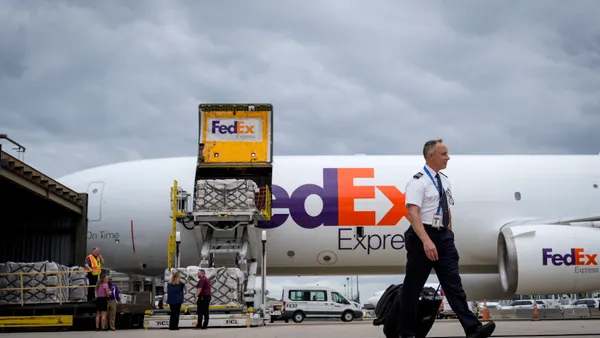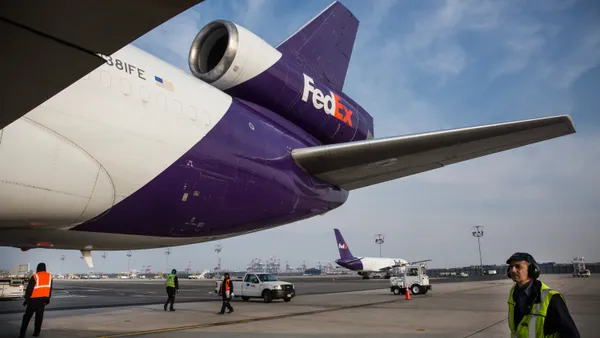Dive Brief:
- Air freight rates are on a downward trajectory as the industry battles trade uncertainty and shifting tariff regulations, despite brief upticks, according to a June 6 Xeneta report.
- The global air cargo spot rate fell 4% year over year in April to $2.44 per kilogram — the first decline since April 2024.
- While China to U.S. seasonal rates are also on a downward trend, by June 1, spot prices on the trade lane bounced back to $4.31 per kilogram, up 14% from its low point the week ending May 11.
Source: Xeneta
Dive Insight:
Rates will likely continue to face downward pressure, said Xeneta Chief Airfreight Officer Niall van de Wouw. He noted that the recent drop is a “reflection of declining sentiment and concerns, particularly among airlines, over what will happen once more stability returns to international trade and there is less of a push for the security of airfreight.”
Although the Trump administration announced a 90-day tariff reprieve in May, the news came too late to reverse the softening trend in freight rates, Xeneta reported.
“Tariffs are of a different overall magnitude in terms of financial impact compared to the cost of using airfreight instead of ocean – this is the clearest business case you can have right now for moving goods by air if you avoid tariffs as a result. This market environment gives, and it takes,” van de Wouw said.
Greater market clarity won’t help create a market buffer either, he added, noting that there will likely be a larger decline. In turn, carriers may try to secure their volumes in a bid for better security.
“So, the moment flights become less full, airlines might just want to settle their rate negotiations a little bit quicker and more keenly – and I think we’re seeing that starting to play out in the negotiation of rates at a global level,” he said.
Amid U.S. trade tensions, air cargo spot rates from Northeast Asia to North America were up 7% YoY to $4.53 per kilogram, Xeneta reported.
Cloudy skies ahead
The end of the de minimis exemption on May 2 also contributed to the market shakeup, prompting a drop in volumes and excess air freight capacity, which led some carriers to redeploy capacity. Although routes are not changing completely, the countries of origin for the flights are shifting to accommodate production being pushed away from China in favor of countries with lower U.S. tariffs.
Some calm has returned to the market, however, as the U.S. lowered tariffs on low-value e-commerce shipments from China and Hong Kong to 54%, or a $100 flat fee for parcel shipments, Xeneta reported.
Rapid changes in a fluctuating trading environment are yet another hurdle the air freight industry must contend with, said van de Wouw. Contingency plans can quickly become obsolete, making strategizing challenging.
According to van de Wouw, the resulting uncertainty has made supply chains “a mess,” prompting a modal shift for goods that wouldn’t ordinarily move by air freight.
“Tariffs are of a different overall magnitude in terms of financial impact compared to the cost of using airfreight instead of ocean – this is the clearest business case you can have right now for moving goods by air if you avoid tariffs as a result,” said van de Wouw. “This market environment gives, and it takes.”
A short-term surge in cargo is also anticipated as the 90-day tariff truce comes to an end July 9 for most countries and Aug. 13 for China, per Xeneta. Frontloading continues to be a mitigation strategy for shippers concerned over ongoing trade talks and tariff changes — including in ocean shipping, as the Port of Los Angeles reported in March.
According to Xeneta, the ocean container shipping market may hint at the future trajectory of the air freight industry, given its longer lead times.
“At the moment, the climate might be positive on certain lanes to airfreight demand, but there will be a time when there’s an agreement on tariffs – and I don’t expect the end result to promote trade and will, therefore, hamper airfreight,” van de Wouw said.














